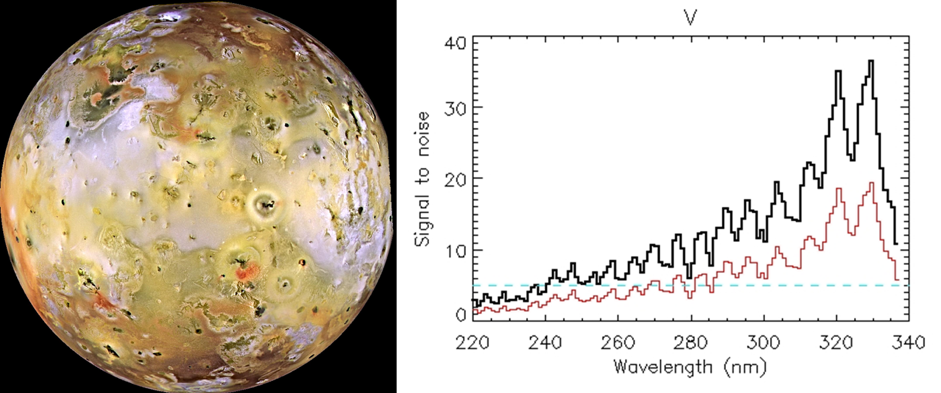Solar System
Surfaces of moons and small bodies
UV observations uniquely probe the surface of atmosphere-free telluric bodies of the solar system. They diagnose their volcanic and plume activity, their interaction with the solar wind and their composition in the frame of space weather and exobiology/habitability fields. When the Sun’s unpolarized light is scattered by a rough surface or a dust covered surface of a solar system body, it becomes partially linearly polarized, and the polarization varies with the phase angle. This can be used to infer the properties of the surfaces of solar system bodies (Geake & Dolfus 1986).The Wisconsin UV PhotoPolarimeter Experiment observations (WUPPE, Fox et al. 1997a) has revealed the Io surface as spatially covered by 25% SO2 frost with polarization variations associated to different volcanic regions. POLLUX will primarily characterize volcanism and/or plume activity of icy moons from polarized solar continuum reflected light and the spectral UV albedo. Its high sensitivity is necessary to track any organic and ice composition of the crust of comets and Kuiper Belt objects from their UV spectrum. The UV spectral regime is fundamental to assess the presence of carbon on primitive bodies such as C, B, D asteroids and comets nuclei, since this element is nearly featureless both in the visible and in the IR. In the UV, carbon in various forms (amorphous, graphitized, hydrogenated, glassy) has a very important peak at 210-220 nm. To date, only in situ observations by spacecraft have been able to study these (e.g. the Rosetta mission at comet 67P, Feaga et al. 2015).
UV polarimetric observations of the Moon show a scattering from grains surface for wavelength < 220 nm, and volume scattering for wavelength > 220 nm (Fox et al. 1998). Such processes explain the change of polarization with phase angle at visible wavelengths (e.g. Steigmann et al. 1978). Systematic observations of the UV polarization of the surface of different objects in the solar system would open a new field of investigation to constrain the surface properties (refractive index, surface roughness, particle size, ...). Such observations could be calibrated/validated with sample returns and then be used to interpret surface properties of exoplanets, or other interstellar objects that cannot be reached by spacecraft.
Cometary comae
Comets show many emission features in their UV spectra, which allow the composition of their gas comae to be measured. At high resolution the composition can be determined at isotopic level, tracing the temperature structure of the solar system’s proto-planetary disc (e.g. Yang et al 2018). Such observations are currently limited to the brightest comets; POLLUX would enable routine isotopic measurements to understand the variation across the full population. The sensitivity of a large UV space telescope would also allow POLLUX to investigate the drivers of cometary activity throughout the solar system. The UV has been identified as a key wavelength regime to investigate the enigmatic activity of the Main Belt comets, where sensitive observations could reveal evidence for the distribution of water within the asteroid belt (Snodgrass et al 2017).Planet atmospheric properties
Several processes can polarize the light in planetary atmospheres: Rayleigh scattering, and scattering by aerosol/cloud particles, etc. The Rayleigh scattering cross section varies as ~ 1/λ4 while the scattering by aerosols/clouds is usually less wavelength dependent. Therefore, the Rayleigh scattering is generally dominant at short wavelengths while aerosols scattering is dominant at large wavelengths within the UV range. The transition between the two processes depends on the size of the aerosols and the atmospheric pressure.On Mars, at a phase angle V = 21.7°, the linear polarized reflected light in the spectral range 200 – 400 nm is due to the tenuous atmosphere, while the reflected total flux in this spectral range is due to the surface and the atmosphere (Fox et al. 1997b). The WUPPE observations were used to retrieve simultaneously the surface albedo and the surface pressure of Mars. Such observations could be extended to derive the UV albedo from less studied bodies with optically thin atmospheres.
On Venus, the polarization is only due to the thick atmosphere. It has been measured at few wavelengths by Pioneer Venus Orbiter for different phase angles showing a contrast in the polarization of the dark and the bright region of the atmosphere of Venus (Esposito & Travis 1982). The UV spectrum at high spectral resolution coordinated with spectral imaging of Venus could be used to derive new information on the unknown absorber responsible for the dark UV regions in which 10% of the incident sunlight is absorbed.
Magnetospheres and aurorae of the giant planets
The giant planets’ UV aurorae are mainly due to atmospheric H atoms and H2 molecules that are collisionally-excited by accelerated charged particles precipitating along the auroral magnetic field lines. Aurorae thus directly probe complex interactions between the ionosphere, the magnetosphere, the moons and the solar wind. Precipitation of aurora particles is a major source of atmospheric heating, knowledge of which is needed to assess the energy budget, the dynamics and the chemical balance of the atmosphere. POLLUX will measure the bright complex aurorae of Jupiter and Saturn, the fainter ones of Uranus, and catch those of Neptune, only seen by Voyager 2 (Lamy et al., 2017). The high spectral resolution will be used to map the energy of precipitating electrons from partial spectral absorption of H2 by hydrocarbons (Gustin et al., 2017) and the thermospheric wind shear from the H Ly-α line (Chaufray et al. 2010). In addition, POLLUX observations of the persistently powerful planetary-like aurorae detected on several nearby cool brown dwarfs would provide critical insights into their magnetospheric/atmospheric interfaces, and into the origin of the precipitating particle streams above these substellar objects that do not involve an external stellar wind (Hallinan et al. 2015). Figure 1: Left : Volcanic activity of the Io surface. Right : Simulated signal-to-noise ratio (SNR) for the Stokes parameter V for an observation of Io surface during an integration
time of one hour and a resolution of 1 nm by POLLUX. Mirror aperture is 15 meters (black line) and 8 meters (red line). The light blue dashed line represents a S/N = 5.
Absorption by SO2 ices causes the large decrease of the SNR below 320 nm.
Figure 1: Left : Volcanic activity of the Io surface. Right : Simulated signal-to-noise ratio (SNR) for the Stokes parameter V for an observation of Io surface during an integration
time of one hour and a resolution of 1 nm by POLLUX. Mirror aperture is 15 meters (black line) and 8 meters (red line). The light blue dashed line represents a S/N = 5.
Absorption by SO2 ices causes the large decrease of the SNR below 320 nm.
|

